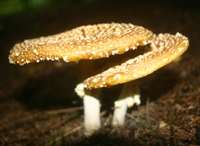Amanita regalis (Fr.) Michael - Brown Fly Agaric
Phylum: Basidiomycota - Class: Agaricomycetes - Order: Agaricales - Family: Amanitaceae
Distribution - Etymology - Taxonomic History - Psychoactivity - Identification - Reference Sources
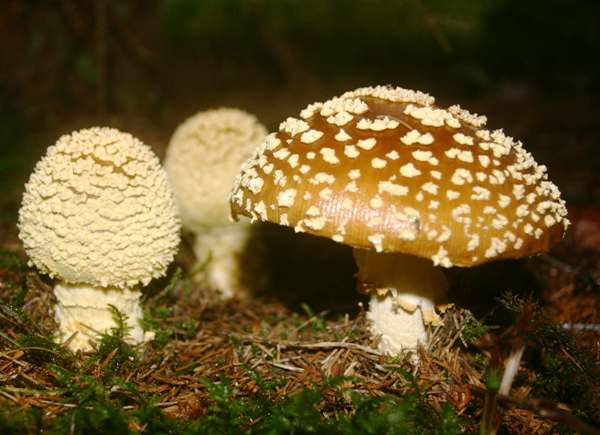
The Brown Fly Agaric, Amanita regalis, is not reported from Britain or Ireland, but it is quite common in Scandinavia. Apart from cap colour it is similar in size and form to the red Fly Agaric.
Like the Fly Agaric, this large member of the genus Amanita is also hallucinogenic and can cause sickness and other distressing effects if it is eaten.
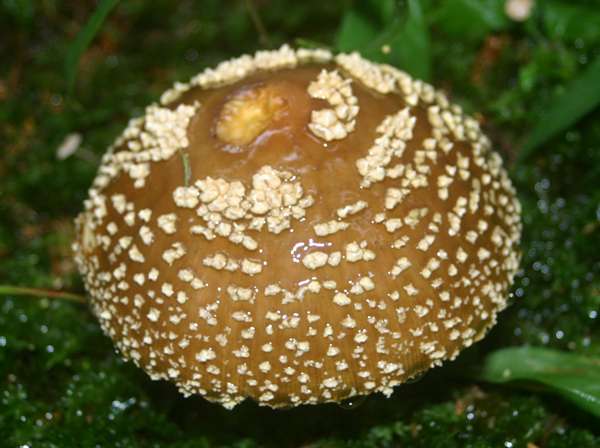
For a detailed description of the Amanita genus and identification of common species see our Simple Amanita Key...
Distribution
The Brown Fly Agaric is fairly common in Scandinavia; I came across the specimens shown on this page while I was visiting southern Sweden in 2005. Amanita regalis occurs also in some eastern European countries as well as in North America, where it is currently recorded only from Alaska. This species has been formally recorded only twice in Britain and is rarely if ever seen in warm southern countries in Europe, where the superficially similar but smaller Panthercap, Amanita pantherina does occur.
Taxonomic history
In his Systema Mycologicum, published in 1821, Elias Magnus Fries described this mushroom under the name Agaricus muscarius β regalis. In 1887 Pier Andrea Saccardo transferred it to the genus Amanita, but only as a variety of the Fly Agaric Amanita muscaria.
It was Edmund Michael (1849 - 1920) who, in 1903, first treated this mushroom as a distinct species, giving it its current name Amanita regalis.
Among the many synonyms of Amanita regalis are Amanita umbrina Pers., Agaricus muscarius var. umbrinus (Pers.) Fr., Amanita muscaria var. regalis (Fr.) Sacc., Amanita emilii Riel and Amanitaria muscaria var. regalis (Fr.) E.-J.Gilbert.
Etymology
The common name Brown Fly Agaric suggests that this might be a very close relative of the Fly Agaric, Amanita muscaria. Indeed it is, and for many years it was treated as a variety of its more famous relative the (red) Fly Agaric; however, nowadays most authorities award it species status. The specific epithet regalis means royal, and among the many common names given to this beautiful mushroom are Royal Fly Agaric, King Fly Agaric, and King of Sweden Amanita.
Psychoactive alkaloid content of Amanita regalis
On the basis of its close genetic relationship with the infamously hallucinogenic Fly Agaric, Amanita muscaria, it is clear that the Brown Fly Agaric can also contain the psychoactive chemical compounds ibotenic acid and muscimol as well as muscazone and muscarine (but they may not always be in significant concentrations). There are more details on our Fly Agaric page...
Amanita regalis is one of my favourite mushrooms - to see, but not to eat. The white or more often yellowish fragments of partial veil which adhere to the cap make this large woodland rarity one of the most beautiful of all fungi, and so it is a great shame that so few people ever get to see them. I have therefore included a few extra pictures in the Identification section below.
Because of its large size and vestigial volva, the Brown Fly Agaric is unlikely to be confused with the Panthercap, Amanita pantherina, but some Blushers (Amanita rubescens) can look quite similar; however, the flesh of a Blusher turns pink when it is damaged whereas cutting a Brown Fly Agaric causes no significant colour change in its flesh.
Identification guide
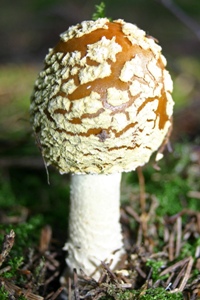 |
CapInitially egg shaped, becoming convex and eventually flattening out to between 10 and 20cm in diameter, the caps of Amanita regalis are glossy brown; usually retaining irregular, white fragments of the universal veil. |
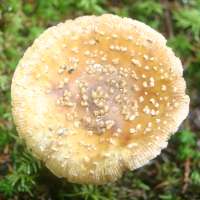 |
At maturity the caps flatten out and occasionally become shallowly concave. Like the closely related Amanita muscaria (Fly Agaric) the Brown Fly Agaric usually retains its warty veil fragments, but in very wet weather the veil fragments can get washed off; this makes misidentification more likely. The volva at the base of the stem is then an important identifying feature. |
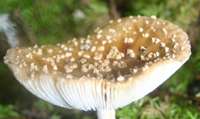 |
GillsWhite, free, crowded. The gills turn pale yellow as the fruitbody matures. |
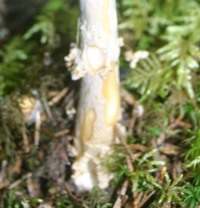 |
Stem10 - 25cm long and 1.5 - 2cm in diameter, the stems of Amanita regalis are white and ragged with a grooved, hanging ring. The swollen base retains the white, sack-like remains of the volva, which eventually fragments into rings of scales around the base of mature specimens. |
SporesBroadly ellipsoidal, 8-10 x 6-7μm; inamyloid. Spore printWhite. |
|
Odour/taste |
Not distinctive. |
Habitat & Ecological role
|
Mycorhizal with conifers, notably spruce as in the case of the mature specimens pictured on the left, and with birches.. |
Season |
August to October in Britain; July to September in Scandinavia. |
Similar species |
Amanita caesarea (Caesar's Mushroom) is rarely if ever found in northern Europe; its cap is brilliant orange without small veil fragments but with a striated margin, and the stipe is yellow. The caps of some examples of Amanita rubescens are glossy brown, but their stems and their cap flesh always turn red when damaged. |
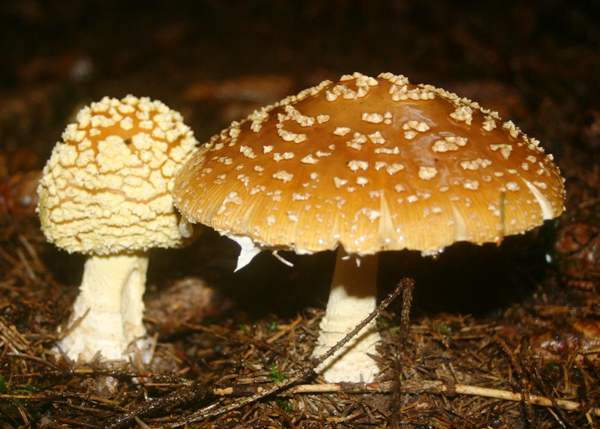
Reference Sources
Fascinated by Fungi, 2nd Edition, Pat O'Reilly 2016, reprinted by Coch-y-bonddu Books in 2022.
Funga Nordica: 2nd edition 2012. Edited by Knudsen, H. & Vesterholt, J. ISBN 9788798396130
BMS List of English Names for Fungi
Geoffrey Kibby, (2012) Genus Amanita in Great Britain, self-published monograph.
Paul M. Kirk, Paul F. Cannon, David W. Minter and J. A. Stalpers (2008). Dictionary of the Fungi; CABI
Taxonomic history and synonym information on these pages is drawn from many sources but in particular from the British Mycological Society's GB Checklist of Fungi.
Fascinated by Fungi. Back by popular demand, Pat O'Reilly's best-selling 450-page hardback book is available now. The latest second edition was republished with a sparkling new cover design in September 2022 by Coch-y-Bonddu Books. Full details and copies are available from the publisher's online bookshop...
